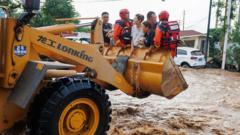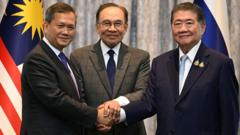The performance of Chinese J-10C fighter jets in the India-Pakistan conflict has stirred nationalist sentiments in China and sparked concerns about Taiwan's defense capabilities.
Chinese Military Hardware Gains Traction Following India-Pakistan Clashes

Chinese Military Hardware Gains Traction Following India-Pakistan Clashes
The recent conflict has spotlighted the prowess of Chinese fighter jets and missiles, influencing regional military dynamics.
China's military-industrial complex has welcomed the perceived success of its J-10C fighter jets and accompanying missile systems amid rising tensions stemming from a recent clash between India and Pakistan. Reports of Pakistani forces utilizing these advanced aircraft to shoot down Indian fighter jets have sent seismic waves of national pride across China, with heightened discussions about its potential implications for Taiwan.
The four-day conflict highlighted Pakistan's air force employing the Chinese-made J-10C jets, leading to claims of various aerial victories against Indian planes. While the Chinese government has not officially validated these claims, the state media has celebrated the J-10C’s debut in combat operations. Prompted by these assertions, experts in China, including former military officials, have hinted at a renewed confidence in the capabilities of their military hardware.
In particular, the portrayal of the J-10C as “the fighter of national pride” in Chinese media reflects a broader narrative of military superiority. Commentaries suggest that Taiwanese defense forces may struggle against this aircraft, raising alarms about potential conflicts in the South China Sea and over Taiwan itself.
The incident underscores the delicate balance of military power in the region. Should the claims by Pakistan remain unchallenged and recognized by China, it could embolden Beijing's territorial aspirations. Observers in Taiwan are finding themselves deeply concerned about how these developments could reshape air defense strategies in the face of potential aggression from China.
The four-day conflict highlighted Pakistan's air force employing the Chinese-made J-10C jets, leading to claims of various aerial victories against Indian planes. While the Chinese government has not officially validated these claims, the state media has celebrated the J-10C’s debut in combat operations. Prompted by these assertions, experts in China, including former military officials, have hinted at a renewed confidence in the capabilities of their military hardware.
In particular, the portrayal of the J-10C as “the fighter of national pride” in Chinese media reflects a broader narrative of military superiority. Commentaries suggest that Taiwanese defense forces may struggle against this aircraft, raising alarms about potential conflicts in the South China Sea and over Taiwan itself.
The incident underscores the delicate balance of military power in the region. Should the claims by Pakistan remain unchallenged and recognized by China, it could embolden Beijing's territorial aspirations. Observers in Taiwan are finding themselves deeply concerned about how these developments could reshape air defense strategies in the face of potential aggression from China.



















